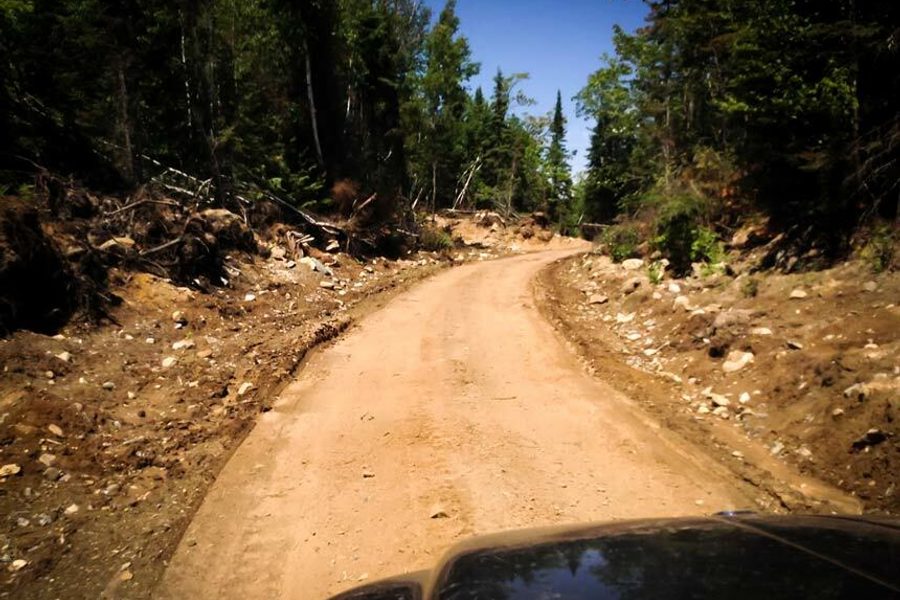
For more than a decade, residents of Michigan’s Upper Peninsula (UP) fought to block the proposed Eagle Mine, billed by the multinational mining company Rio Tinto as a means to access one of the most significant nickel deposits in the country. They lost that fight; after years of legal challenges and regulatory hurdles, Eagle Mine opened last year. But the mine’s opponents haven’t given up fighting to protect the UP from encroaching industry. Now, much of their energy is being directed against a proposed road from the mine to an ore-processing mill, which they fear could turn the UP’s sensitive wetlands into an industrial corridor.
The Eagle Mine faced strong opposition from locals fearing contamination of the marshy and delicate Yellow Dog Plains, the Salmon Trout and Yellow Dog rivers and Lake Superior, as well as damage to the outdoor tourism industry so crucial to the local economy. The Keweenaw Bay Indian Community (KBIC) argued that the mine construction would violate their treaty rights, as it would blast under Eagle Rock, a sacred landmark.
Ultimately, various legal challenges failed, and the necessary permits for the mine, which in 2013 was sold to the Canadian mining company Lundin, were obtained. By fall 2014, the mine had ramped up to full production (2,000 tons of ore per day), and a dirt road called AAA was paved for trucks to pass 24 hours a day, making the 60-mile journey to Humboldt Mill. The trucks also drive right through the small city of Marquette and the campus of Northern Michigan University.
Local conservationists didn’t want AAA paved, and many people don’t like the trucks coming through Marquette. But they’re even more alarmed by a proposal to build a new, 21-mile direct route between the mine and Humboldt Mill. That road would plough through the ecologically fragile marshes and woodland habitat for moose and other animals—“the green heart that provides the lifeblood of Lake Superior,” as Jeffery Loman, a KBIC member and former oil and gas regulator for the federal government, puts it.
Rio Tinto had pushed to build such a road in 2009 and offered to pay the cost, but the proposal died in the face of objections from federal agencies, including the Environmental Protection Agency (EPA), concerned about the impact on wildlife. In 2010, the Marquette County Road Commission revived the proposal, calling for a county road to be named 595 with a route almost identical to the one pushed by Rio Tinto. Once again, the EPA put its foot down. Conservationists believed they had won.
But in January, the road commission voted to file a lawsuit against the EPA to challenge the roadblock. Michigan state legislators—most prominently State Sen. Tom Casperson (R)—sponsored a resolution supporting the road, tapping into resentment against the federal government (and the EPA in particular).
The conflict over the 595 is no longer just about Eagle Mine. Ironically, Lundin spokesperson Dan Blondeau says the company is satisfied with the current road situation. But in an email to In These Times, road commission engineer-manager Jim Iwanicki writes that the $82.5 million proposed road “is necessary to serve the mining, timber, aggregate and recreation industries, as well as emergency services in Marquette County.”
Critics of the 595 project now fear the road will act as a catalyst for more mining and logging by creating a convenient processing route. Catherine Parker, a long-time UP resident, says it would be an artery for a variety of development projects. “They’ll come up with anything they can to justify that road,” she says.
There are currently dozens of other mining projects in the exploration phase in the UP and surrounding Lake Superior, and many locals welcome the idea of a mining resurgence, hoping for jobs and economic vitality. According to Blondeau, Eagle Mine and Humboldt Mill employ roughly 185 people directly and 165 contractors.
But others fear that the wilds of the UP will be drastically transformed. “We’re being bulldozed by industry,” says Alexandra Maxwell, interim director of the grassroots environmental group Save the Wild UP (SWUP).
The lawsuit challenging the EPA’s roadblock, which reportedly could cost up to half a million dollars to pursue, will be funded by a new non-profit 501(c)4 group known as Stand UP. Its funders are allowed to be anonymous.
“These won’t be mom and pop donors,” says Alexandra Thebert, the former executive director of SWUP. “This is how mining and logging companies could donate a million dollars and be anonymous.”
Stu Bradley, a retired Air Force colonel who lives near Marquette, is the secretary/treasurer of Stand UP. As of late March, he said, all the donations had been in the $50 to $100 range, though he expected bigger donations to start coming in. Bradley says the main advantages he sees to the new road are reduced fuel emissions and increased street safety compared with the current route.
As lawmakers and interest groups put increasing pressure on the EPA to let the road go forward, members of the KBIC tribe, SWUP and other locals have been exerting their own pressure, attending road commission meetings, filing Freedom of Information Act requests, and writing letters to government officials and local newspapers. At the same time, they’re still keeping a close eye on Eagle Mine, “making sure they follow the letter of the law,” Maxwell says.
In June 2013, Jeffery Loman and SWUP filed a notice alerting the EPA that they will file a lawsuit under the Clean Water Act if any water is contaminated by mining, and the KBIC tribe and the non-profit Yellow Dog Watershed Preserve are working along with the U.S. Geological Survey to test nearby bodies of water.
Though Eagle Mine is a done deal, residents say the struggle stoked a lasting opposition to the further industrialization of the UP. For three days in late March, tribal members and activists from around the region convened at the Mackinac Bridge, which connects the UP to the rest of Michigan, to protest a proposed limestone mine known as Graymont.
“The rights of Michigan citizens who use and enjoy this area,” read a statement from the Sault Ste. Marie Tribe of Chippewa Indians, “shouldn’t be traded for vague promises of eco nomic prosperity.”
Kari Lydersen is a Chicago-based journalist, author and assistant professor at Northwestern University, where she leads the investigative specialization at the Medill School of Journalism, Media, Integrated Marketing Communications. Her books include Mayor 1%: Rahm Emanuel and the Rise of Chicago’s 99%.









